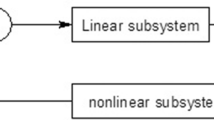The hydraulics equations are reduced to the form of the equations of nonlinear electric circuits by introducing hydraulic resistances, which are analogous to electric resistances. The hydraulic resistances depend on unknown discharges and are calculated from the discharges on the previous iteration. As a result, on the new iteration step it is possible to solve a system of linear equations, from which discharges on the iteration half-step are found. Discharges on the new iteration step are represented as linear combinations of discharges on the half-step and on the previous step. The possibilities of the method are shown using the example of a hydrosystem with two pumps and three flow governors.
Similar content being viewed by others
References
N. N. Kalitkin, Numerical Methods, Nauka, Moscow (1978).
A. A. Samarskii and A. V. Gulin, Numerical Methods, Nauka, Moscow (1989).
N. M. Zinger, Hydraulic and Thermal Regimes of Central-Heating Systems, Énergoatomizdat, Moscow (1986).
C. O. Bennett and J. E. Myers, Momentum, Heat Mass Transfer, McGraw-Hill, New York, 1962.
B. A. Unaspekov, K. O. Sabdenov, M. Erzada, and B. A. Igembaev, Thermal regime in a building in the presence of mixing of heat carriers from delivery and return pipelines, J. Eng. Phys. Thermophys., 87, No. 1, 75–82 (2014).
K. O. Sabdenov, T. M. Baitasov, and M. Erzada, Optimum control of heat supply of a buiding. 1. Formulation of the problem and basic formulas, J. Eng. Phys. Thermophys., 87, No. 4, 839–847 (2014).
E. Orlando (Ed.), Energy Plus. Engineering Reference, University of Illinois and University of California, 2013; http://energy.gov/eere/office-energy-efficiency-renewable-energy.
Bharathwaj Mathuswamy and Santo Banerjee, Introduction to Nonlinear Circuits and Networks, Springer, Switzerland (2019).
G. D. Chavchanidze and A. A. Artemov, Calculation of D.C. Circuits, Ross. Univ. Transp., Moscow (2018).
V. V. Polyakov and L. S. Skvortsov, Pumps and Fans, Stroiizdat, Moscow (1990).
M. Cherkasskii, Pumps, Fans, and Compressors, Énergiya, Moscow (1977).
Author information
Authors and Affiliations
Corresponding author
Additional information
Translated from Inzhenerno-Fizicheskii Zhurnal, Vol. 94, No. 1, pp. 188–194, January–February, 2021.
Rights and permissions
About this article
Cite this article
Sabdenov, K.O. A Numerical Method for Solving the Equations of Hydraulics and of Nonlinear Electric DC Circuits. J Eng Phys Thermophy 94, 179–185 (2021). https://doi.org/10.1007/s10891-021-02287-9
Received:
Published:
Issue Date:
DOI: https://doi.org/10.1007/s10891-021-02287-9




